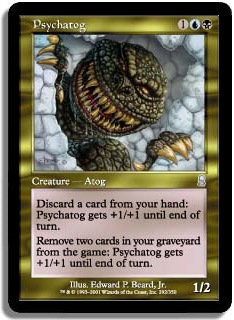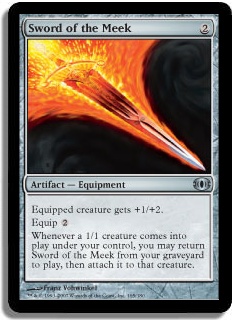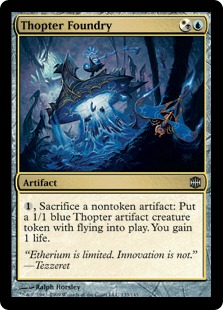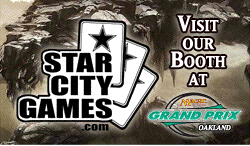Remember this guy?

That’s what I feel like when I am playing with this:


It started Thursday, January 7th around 3am. I had been testing Extended exclusively for the past couple of days online, and didn’t like any of the stock decks or goofy creations that I had made. I was having success with Dredge online, but it was total grind since beating the first or second hate card was easy, but beating the third one was a total pain in the ass.
I was tired of grinding it out with Bloodghast and friends. I wanted something more… broken, I guess. I was hellbent on finding it. Even if it meant I had to play Blue cards…
Enter an instant message from Alaska’s finest import, Steven Birklid. I congratulated him on his Top 8 at the Seattle PTQ and asked him how his deck was:
“The deck is insane. I played it on no practice and felt like I could never lose. My loss in the Top 8 was a mulligan to three in game 3 against Scapeshift.”
That was a resounding endorsement. I decided to put his decklist underneath the magnifying glass:
3 Chrome Mox
2 Cryptic Command
3 Engineered Explosives
3 Mana Leak
4 Muddle the Mixture
4 Path to Exile
4 Spell Snare
3 Sword of the Meek
3 Talisman of Progress
3 Tezzeret the Seeker
4 Thirst for Knowledge
4 Thopter Foundry
1 Academy Ruins
4 Ancient Den
3 Hallowed Fountain
4 Island
1 Misty Rainforest
2 Plains
1 Scadling Tarn
4 Seat of the Synod
Sideboard
1 Chalice of the Void
4 Meddling Mage
1 Relic of Progenitus
1 Tormod’s Crypt
3 Trinket Mage
2 Vendilion Clique
3 Wrath of God
There were a lot of things I liked about this decklist:
1) I felt that Thopter Foundry + Sword of the Meek was one of, and quite possibly, the most powerful thing you could achieve in the format. To say how powerful the combination is in words simply does not do it justice.
2) I really liked how this deck was obsessed with assembling the combination of Thopter Foundry + Sword of the Meek and nothing else. I didn’t like LSV’s deck from Worlds very much, because it screwed around a lot and then assembled the combo. Why go through all the work resolving Gifts Ungiven and playing terrible cards like Aether Spellbomb when you can simply go turn 1 Thopter Foundry, turn 2 Sword of the Meek, deal with this or die!
3) I really enjoyed the fact how redundant the combo was. Once you assemble it, sure they can break it up, but you can just go get another Thopter Foundry and force them to deal with it again via Muddle the Mixture or Tezzeret the Seeker. Many times in testing, Qasali Pridemage, Bant Charm, and who knows what else would deal with my first two Thopter Foundries. I would then simply get a third one, and dare them to beat that one too. Often, they couldn’t.
However, there were a few things I didn’t like about Mr. Birklid’s decklist:
1) Talisman of Progress really felt weak to me. I understand the purpose of the card is to ramp into Tezzeret the Seeker as well as giving you a card to sacrifice to Thopter Foundry, but it just felt very underpowered. I don’t like to pay mana for my lands very often. I’d rather just play a land instead. Sometimes even 43 of them.
2) 4 Ancient Den and 4 Seat of the Synod was a giant risk. Artifact lands interact very favorably within this deck, but at what cost? The first time you have your first two lands blown up by Ancient Grudge, even if it is the wrong play by your opponent, you will actually want to top yourself. It happened to me enough times in my initial testing that I opted to cut back on a few of them.
3) Meddling Mage was very unimpressive. Most know this by now, but everyone is ready for Meddling Mage. It doesn’t catch a well-prepared player off guard and needed to be replaced ASAP.
Birklid and I got to talking about what he beat on the day and a lot of things sounded impressive about his deck. No matter what the matchup is, any deck can simply fold to Thopter Foundry + Sword of the Meek, and that is something that should not be overlooked. After a long chat that caused me to stay up way too late, I settled upon the following decklist:
4 Path to Exile
4 Spell Snare
4 Mana Leak
4 Thirst for Knowledge
3 Muddle the Mixture
3 Cryptic Command
4 Chrome Mox
4 Thopter Foundry
3 Sword of the Meek
3 Engineered Explosives
1 Krark-Clan Ironworks
5 Island
4 Ancient Den
4 Seat of the Synod
3 Hallowed Fountain
2 Mystic Gate
2 Plains
1 Academy Ruins
Sideboard
4 Kitchen Finks
3 Relic of Progenitus
2 Tormod’s Crypt
2 Shadow of Doubt
2 Last Breath
2 Mindbreak Trap
I went 6-2 in the Indianapolis PTQ, which I consider a giant failure since I felt I had the best deck in the room, and not winning the PTQ is a failure in and of itself. Matt Severa also played the deck, and we both ran into the same problems:
1) The deck didn’t see enough cards per game. Severa and I both kept running into the issue of having one piece of the combo but not the other, because it got blown up or we simply hadn’t drawn it yet. Each time this happened, if we had a way to see more cards, we would have easily won. Instead, we were both relying on our draw step, which is not what a Blue deck should do.
2) Tezzeret the Seeker was underperforming. Tezzeret the Seeker seems like it should have a home in this deck, but in our games we found that simply was not the case. Tezzeret is a very expensive combo piece, and often a combo piece that you don’t even get to use right away. Tezzeret giving you an alternate way to win the game was nice, but it rarely came up. Many times, I would draw Tezzeret, search for a combo piece, have my Tezzeret killed by an attack, and be left wondering why I was tapping out for such a mediocre card.
3) Krark-Clan Ironworks was unnecessary. The idea behind the Krark-Clan Ironworks was to go infinite against Scapeshift and other Thopter Foundry decks. Scapeshift is favored game 1 unless I drew a lot of Muddle the Mixtures, and the mirror can get a little degenerate at times, so I wanted a way to avoid that. It wasn’t much of a surprise that Krark-Clan Ironworks was bad, but I think I just really wanted it to be good. It’s not.
The cards in the sideboard that may look unusual are Last Breath and Mindbreak Trap. Last Breath was there to deal with cards that would disrupt the combo, or just all around good cards from other decks. Qasali Pridemage, Vampire Hexmage, Doran the Siege Tower, Dark Confidant, Gaddock Teeg, and Meddling Mage all die to Last Breath. The card is also tutorable via Muddle the Mixture. It was quite good but unnecessary now.
Mindbreak Trap was there to handle Scapeshift that was cast through Boseiju, Who Shelters All, as well as All-In Red decks. This was an oversight on my part, as All-In Red was a very good matchup as long as I mulliganed correctly, and a four-mana counterspell is not the correct way to fight an uncounterable Scapeshift.
I headed home disappointed, but remained positive. I knew I was on to a very good deck, but changes needed to be made. I sent the deck to AJ Sacher, and we discussed some things. He was a very big fan of the deck idea and got to battling. A few days went by, and we both noticed the need to draw more cards as well. I suggested Ponder as a way to see more cards on the recommendation of Patrick Chapin, but it was not all that impressive.
“What about Ancestral Vision?” asked AJ.
“Doesn’t hurt to give it a try.” I said
And that is when the lightbulb went off.
Trying to play this as a combo deck just wasn’t a good idea. It worked well enough, but there were so many other things we could be doing while assembling the combo. We could be countering spells, killing guys, and drawing cards. And if we did assemble the combo early, we could look at our opponent and dare them to get through it.
Kind of like what Psychatog used to do.
Draw a bunch of cards, kill a bunch of creatures, and counter a bunch of spells. It just so happened that Psychatog was the best creature in the format, and the best win condition available.
While nothing Thopter Foundry does will ever match the power of Psychatog, I’m willing to say it’s the closest we have seen in a while.
So, after many test games on Magic Online and a lot of brainstorming and goldfishing, I took this list to the PTQ in Chicago last weekend:
Lands (21)
Spells (39)
- 3 Mana Leak
- 4 Thirst for Knowledge
- 4 Chrome Mox
- 3 Engineered Explosives
- 3 Muddle the Mixture
- 4 Spell Snare
- 4 Ancestral Vision
- 3 Sword of the Meek
- 3 Cryptic Command
- 4 Path to Exile
- 4 Thopter Foundry
Sideboard

I went 2-2-1 in the PTQ, which was another major disappoint for me, but I learned enough things to consider it a success:
1) A back-up win condition was necessary. Fighting Extirpate is hard, especially if they have a way to blow up your artifacts as well. A deck like R/G Scapeshift has access to Extirpate, Ancient Grudge, and even Thought Hemorrhage / Cranial Extraction. It’s easy to say that you can just put two Sword of the Meek in play with a Thopter Foundry and dare them to beat it, but it’s not like they are twiddling their thumbs. They are casting spells and playing Magic too. I’ve been Extirpated enough times over the past two weeks to know that by simply adding in a few win conditions in the sideboard, my results against people sideboarding in Extirpates / Ancient Grudges would change dramatically.
2) You have to play this deck very quickly. I passed the turn with about 30 seconds left on the clock against Living End, and he landcycled in my end step. He took a pretty long time to get his land, and when time was called, I was technically the active player, though my activity stopped long ago. As a result, my opponent had turns 1, 3, and 5 to my 2 and 4. On turn 5 my opponent was dead on board, with me holding Negate, Muddle the Mixture, Day of Judgment, and Path to Exile for whatever he dared to do. Getting that draw didn’t feel good, but in the end, I probably played too slowly somewhere, so chances are it was my fault. There are a lot of decisions to be made when playing this deck, so you have to know what you are doing or trying to achieve in every phase of the game. Thinking too long can, and probably will, result in you getting a draw.
3.) The best way to fight Scapeshift is with Shadow of Doubt. It is just not a card that they can really beat if you have another counterspell in your hand. They typically protect their Scapeshift with a Cryptic Command, which you can counter back, or they use a Remand, which does nothing against Shadow of Doubt as long as you have mana available. Shadow of Doubt also trumps Boseiju, Who Shelters All.
Disappointed once again, I got home and got a message from AJ:
“I conceded the finals of my PTQ today.”
That was the best news I heard all day. Even though I did poorly, the work was paying off. After talking to AJ about his PTQ, it became evident that everyone was behind and we were very far ahead in the format. It’s rare that I play a Blue deck, because I don’t play them particularly well unless I have a ton of games underneath my belt, but this is one of the best decks I have played in a long time.
This is the most up to date list that I have been testing online, to great success:
Lands (22)
Spells (38)
- 3 Mana Leak
- 4 Thirst for Knowledge
- 3 Chrome Mox
- 3 Engineered Explosives
- 3 Muddle the Mixture
- 4 Spell Snare
- 4 Ancestral Vision
- 3 Sword of the Meek
- 3 Cryptic Command
- 4 Path to Exile
- 4 Thopter Foundry
Sideboard

A card by card analysis is in order, I suppose:
Ancestral Vision – The backbone of the deck. Somehow, Ancestral Vision has been seeing next to no play in Extended outside of Faeries. This is a card too powerful not to see a ton of play, and it is the card that brought this deck to life. Enjoy drawing far too many cards once more.
Path to Exile – The best removal spell in the format. It is the only reason to play White over Black, as Black gives you better mana (River of Tears) and potentially better sideboard options (Duress, Thoughtseize, Extirpate).
Spell Snare – The classic catch-all counterspell. It takes care of early rushes and wins counterwars far more often than it should.
Thirst for Knowledge – The second best card drawing spell in our deck, but one that is very at home here. We have plenty of artifacts to discard, and some that we even want to discard in Sword of the Meek.
Mana Leak – Never impressive but always gets the job done. Mana Leak is the card that keeps decks like Burn, Zoo, and Doran honest. It is simply a necessary evil.
Muddle the Mixture – The do-all for this deck. It counters Scapeshift and other problematic spells, tutors for each piece of the combo, and even makes our sideboard cards better as it can tutor for a lot of those as well.
Cryptic Command – What doesn’t this card do? Honestly, you tell me something this card cannot do. I’d run four if I could, but it isn’t feasible.
Thopter Foundry + Sword of the Meek – The Tag Team Champions. Good luck beating these guys in tandem.
Engineered Explosives – A nice catch-all and our best card against Zoo and Combo Elves. This card is a staple of Extended control decks.
The manabase is pretty basic. Steam Vents is here to be able to set Engineered Explosives for three, as well as being able to pay for Pact of the Titan from Hive Mind. I’ve been playing two Academy Ruins lately, and I feel the good outweighs the bad. Sometimes you do draw two Academy Ruins and you want to shoot yourself, but the times that you are activating it for value simply make it too good.
Pristine Angel – I wanted a card I could sideboard in that would be able to win games where I get Extirpated, and have that creature not be able to be killed. It was between this and Sphinx of Jwar Isle, and Pristine Angel has been testing far better. First off, RG Scapeshift does not want to play against this card as they can never get through it, and realistically never kill it as long as you are playing correctly. I’ve also been sideboarding it in against GerryT’s PTQ-winning Dark Depths/Thopter Foundry deck, with very positive results. Because you are able to deal with both parts of his deck fairly reasonably, you need a way to dodge their Extirpates and actually win the game. Pristine Angel is a way to do that, and it also holds off an angry 20/20 token. Against a deck like Death Cloud that is going to go out of its way to make your Thopters irrelevant (Night of Souls’ Betrayal, Extirpate, Cranial Extraction) you need another way to beat them. The only reason I like this more than Baneslayer Angel is because it just does not die if you handle it correctly. And the picture is much nicer too (it’s my desktop background).
Shadow of Doubt – One of the best sideboard cards in the format right now, Shadow of Doubt blanks a Scapeshift, is very good against the bevy of tutors from Dark Depths, and can protect you for a turn against Extirpate if you choose to set it up that way. Did I mention it cantrips? This is the card Scapeshift does not want to play against. Not Meddling Mage. Not Gaddock Teeg. Shadow of Doubt.
Wrath of God – Because I am often sideboarding in Pristine Angel to avoid being wrecked by answers to the Tag Team Champions, Wrath of God allows us to sideboard into a U/W Control deck. If you look at the cards in our maindeck, it is very easy to morph into a U/W Control deck. Wrath of God is a card you actively want to draw against Zoo, Affinity, Doran, and any form of a Bant deck. It will buy you the time you need to resolve your card drawing spells and just bury your opponent in card advantage.
Negate – Another hard counter is necessary in certain matchups, and Negate is easily the best one available. Negate is so cheap for the effect that it provides. Very few spells say “No!” as well as Negate does.
Celestial Purge – A tutorable removal spell that takes care of a bevy of problems. Leyline of the Void, Night of Souls’ Betrayal, a Dark Depths token, Dark Confidant, Doran the Siege Tower, any red dork, and even Blood Moon are all handled for 1W.
Disenchant – This spot has been changing a lot. I had a Hurkyl’s Recall here for a while, to win the mirror match and to blow out Affinity, but it wasn’t really that necessary. I am trying Disenchant now as another good card in a mirror style matchup. Chances are it won’t pan out, but that is what testing is for.
Engineered Explosives – The fourth one is to make sure I don’t lose to the wildest of Nacatls.
As far as sideboarding goes, I don’t really have anything concrete yet. It really depends on what you think your opponent is sideboarding in. A lot of the time, you can tell if they just immediately go reaching for Ancient Grudge, Extirpate, and whatever else will destroy the Tag Team Champions. In other matchups, it’s very obvious when a card like Path to Exile is bad and needs to come out in favor of more countermagic (I’m looking at you, Scapeshift!) When playing Blue, things change based on what spells they play game 1 and what you need to accomplish in the later games. As I test more, I will be able to put something together that is more concrete for everyone, but at this point, I don’t want to mislead everyone because I am still losing some matches due to improper sideboarding myself.
Thopter Foundry is a deck that I feel is so much better than so many of the other decks in the format. I don’t understand why people are going out of their way to play fewer pieces of the combo, when in the end, the combo is what you are trying to achieve. Yes, Sword of the Meek is not good on its own, but the combo is so powerful that you want to give yourself the best chance to naturally draw it.
As I said earlier, it is extremely rare that I endorse a Blue deck. The last time I played a Blue deck consistently was Solar Flare two years ago, and that was only because it was miles ahead of every other deck in that Constructed format. I feel the same way about this deck, and I can’t see myself playing anything else.
One thing you have to do with Thopter Foundry is constantly adjust your sideboard. Earlier, I was playing Kitchen Finks to better my matchup against Zoo. With Combo Elves dominating recently, and articles being written about the best way to break up the combo, I decided to add an alternate win condition and Wrath of God to my sideboard. Extended is a very fast-paced format. With so many relevant Extended tournaments, fresh results keep pouring in. It is imperative that one is not a week behind when constructing a sideboard for this deck, because some of the cards will be useless if you do.
In the end, I would 100% recommend this deck to anyone looking to win a PTQ for the next few weeks. We have no idea how much Worldwake will change things, but for pre-Worldwake, I truly believe this is the best deck in the format, and it isn’t relatively close.
I’ll do my best to field all questions anyone may have, but here is an answer to a question I’m sure someone will inevitably ask:
Yes, I am conceding to Dredge.
caphilli@purdue.edu

